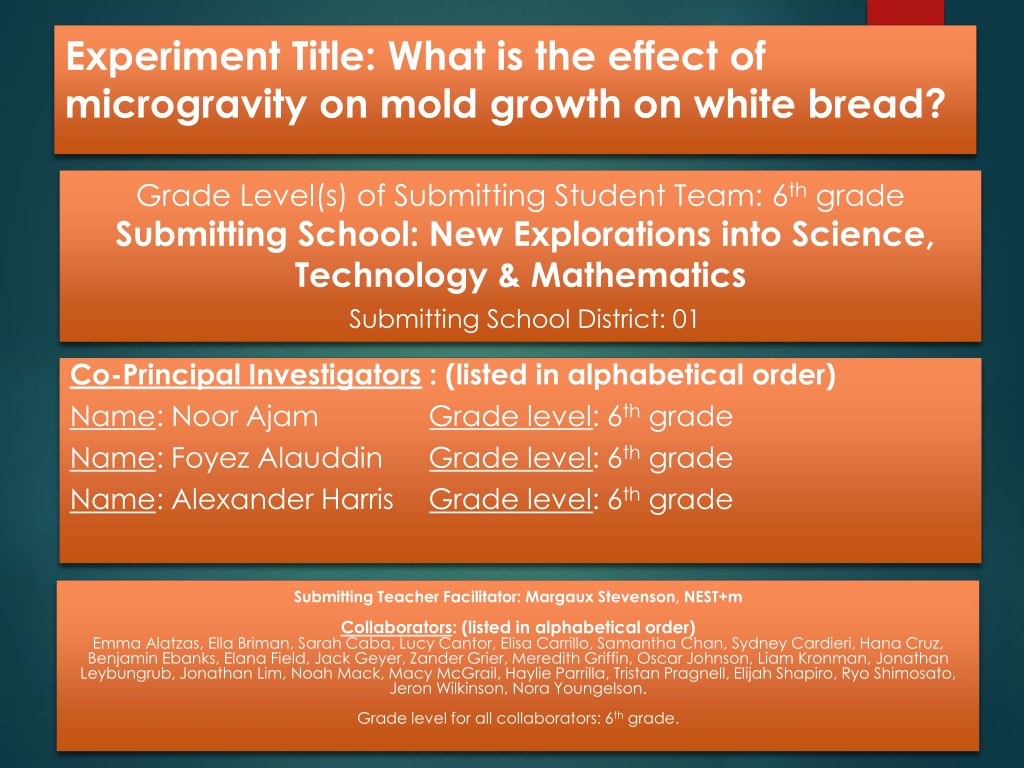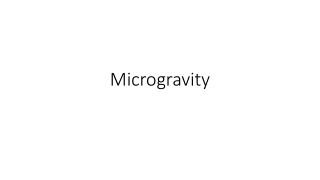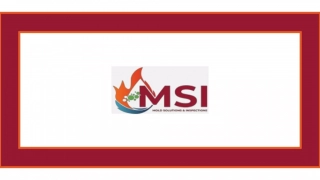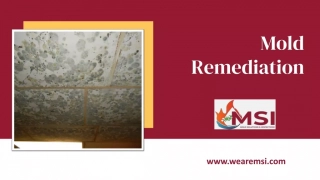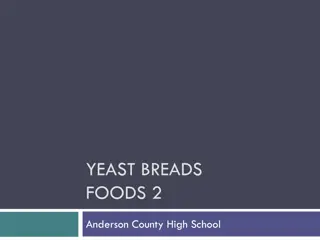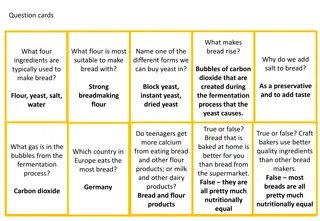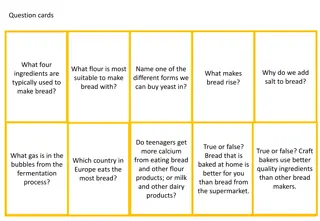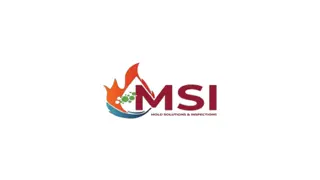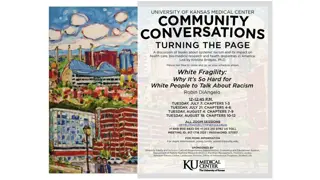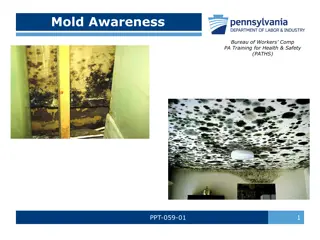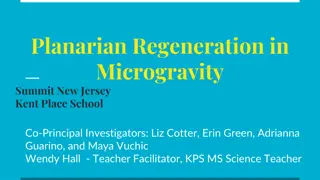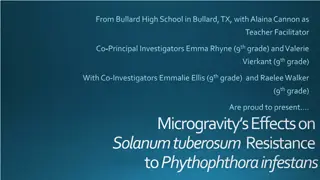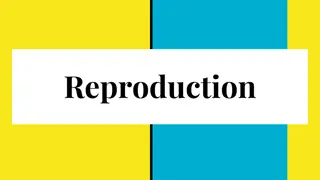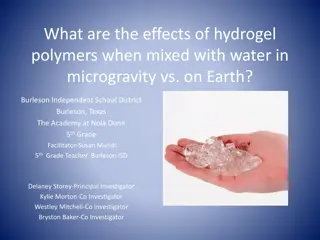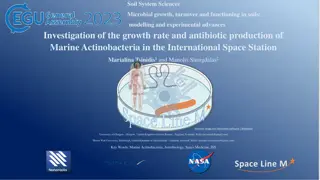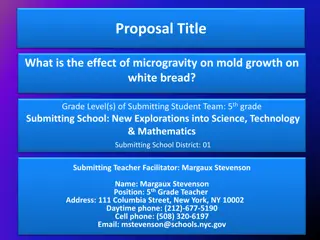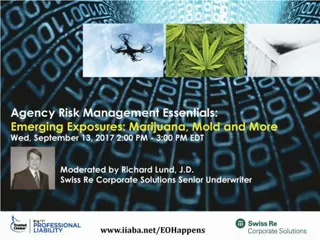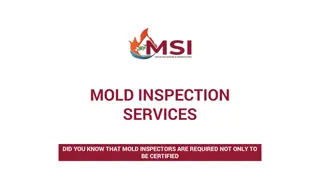Impact of Microgravity on Mold Growth on White Bread
This experiment investigates the effect of microgravity on mold growth on white bread. The team of 6th graders from New Explorations into Science, Technology & Mathematics aims to understand mold dust in the air, mold spores reproduction, and the conditions necessary for mold growth. Using an FME type two tube containing white bread and formalin, they plan to measure results through square inches and spore count. The experiment seeks to gain insights into how microgravity influences mold growth dynamics.
Download Presentation

Please find below an Image/Link to download the presentation.
The content on the website is provided AS IS for your information and personal use only. It may not be sold, licensed, or shared on other websites without obtaining consent from the author. Download presentation by click this link. If you encounter any issues during the download, it is possible that the publisher has removed the file from their server.
E N D
Presentation Transcript
Experiment Title: What is the effect of microgravity on mold growth on white bread? Grade Level(s) of Submitting Student Team: 6th grade Submitting School: New Explorations into Science, Technology & Mathematics Submitting School District: 01 Co-Principal Investigators : (listed in alphabetical order) Name: Noor Ajam Grade level: 6thgrade Name: Foyez Alauddin Grade level: 6thgrade Name: Alexander Harris Grade level: 6thgrade Submitting Teacher Facilitator: Margaux Stevenson, NEST+m Collaborators: (listed in alphabetical order) Emma Alatzas, Ella Briman, Sarah Caba, Lucy Cantor, Elisa Carrillo, Samantha Chan, Sydney Cardieri, Hana Cruz, Benjamin Ebanks, Elana Field, Jack Geyer, Zander Grier, Meredith Griffin, Oscar Johnson, Liam Kronman, Jonathan Leybungrub, Jonathan Lim, Noah Mack, Macy McGrail, Haylie Parrilla, Tristan Pragnell, Elijah Shapiro, Ryo Shimosato, Jeron Wilkinson, Nora Youngelson. Grade level for all collaborators: 6th grade.
Experiment Summary OUR QUESTION: WHAT IS THE EFFECT OF MICROGRAVITY ON MOLD GROWTH ON WHITE BREAD? -We wanted to do this experiment because we did not know much about mold growth, and were very interested in learning about a new topic in microgravity -We used an FME type two tube to contain white bread and formalin, a fixative -Our procedure was to leave the bread alone until D-2 days, when the formalin will be released -We hoped to gain insight into the amount of mold dust in the air, as mold starts out as dust -We planned to measure results through square inches and spore count
The Question to be Addressed by the Experiment - Our question for this experiment was What is the effect of microgravity on mold growth on white bread? -Knowledge going into experiment: -Bread mold can be black, green, or blue -Bread mold is formed by mold spores reproducing -Spores are 3-40 microns in size to reproduce with -Mold starts out as dust, floats in air until it finds food to land on/other spores -Mold is fungi environment -You need mold spores, food spores can thrive on, and a warm and moist -Mold does not grow well in cold -Insight will be gained into the amount of mold dust in the air, as mold starts out as dust
Experiment Design -We chose bread for our experiment because mold grows well on it -The one initiation process for our experiment was to release formalin at D-2 days for both the space and ground setups; we will do this to prevent mold from growing when the micro-gravitational setup returns to a gravitational environment -We planned to measure the results through square inches and spore count Using the Electron Microscope Loading elements
Pictures Photograph of ground setup under Electron Microscope Photograph of space setup under Compound Microscope Photograph of space setup under Electron Microscope Photograph of space setup under Electron Microscope
Pictures (cont.) Looking at bread with BioBase director Latasha Wright at BioBase From left to right: teacher facilitator Margaux Stevenson, co-principal investigators Alexander Harris, Noor Ajam, and Foyez Alauddin
Results and Data Analysis Since both breads were both completely covered in mold, we deemed measurements unnecessary We have concluded that there is minimal to no difference between mold growth on white bread in a gravitational and micro-gravitational environment We used an electron microscope and compound microscope to analyze the breads If we were to do anything differently, we would try to better control the temperatures of both samples in order to produce more reliable results
Acknowledgements The Student Team would like to thank our teacher, Ms. Stevenson; NEST+m s SSEP program administrator and NEST+m Assistant Principal Mr. Brendan Alfieri; and NEST+m science teacher Mr. Marvin Cardornigara. We would also like to thank the SSEP people, The Center for the Advancement of Science in Space, The New York State Space Grant Consortium (Cornell University), BioBase the NYC Department of Education, and the NEST+m PTA. Letter of Certification by the Teacher Facilitator November 4, 2013 I certify that the student team designed the experiment described herein and authored this proposal, and not a teacher, parent, or other adult. I recognize that the purpose of this letter is to ensure that there was no adult serving to lead experiment definition and design, or write the proposal, and thereby provide content and/or professional expertise beyond that expected of a student-designed and student-proposed experiment. I also understand that NCESSE recognizes that facilitation of thinking across the student team by the team s Teacher Facilitator, and other teachers, parents, and local area researchers, is not only to be encouraged but is absolutely vital if students are to receive the necessary guidance on the process of scientific inquiry, experimental design, how to do background research in relevant science disciplines, and on writing the proposal. I also certify that the samples list and the special handling requests listed in this proposal are accurate and conform to the requirements for SSEP Mission 5 to ISS. I confirm that the team, after reviewing their procedure and budget for obtaining the samples for the experiment, is certain that they will be able to obtain the necessary samples for their experiment in time to meet the deadline for shipping the flight-ready FME to NanoRacks. If using human samples, the team is aware that these samples must be tested for prohibited viruses before the experiment can be selected for flight. Finally, the Teacher Facilitator certifies that the student team will have access to the proper facilities to prepare the Fluid Mixing Enclosure for flight and to analyze the samples after the flight. Margaux Stevenson Teacher Facilitator
